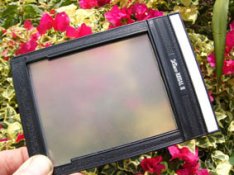FOTOCAT
Member
- Joined
- Aug 11, 2006
- Messages
- 5
- Format
- Medium Format
In getting back into large format, I wanted to share some bad news and some good news.
The bad news-I spent weeks retesting my film choices, developing techniques, etc. and was satisfied with everything except a consistent lack of fine focus of my negatives. Checked everything-focusing loupe, eyeglasses, scanner and enlarger focus, etc---still mushy! Suddenly the lights came on, and a quick check of the focal plane of my ground glass revealed that I was almost 3/16" off after replacing the Fresnel on my Wista field camera. An accurate shim job brought it to the film plane--how stupid!
The good news-my choce of TMax-RS developer with TM-100 has not only performed well, but the mixed developer has performed repeatedly after being mixed for over six months-an admirable shelf life.
The bad news-I spent weeks retesting my film choices, developing techniques, etc. and was satisfied with everything except a consistent lack of fine focus of my negatives. Checked everything-focusing loupe, eyeglasses, scanner and enlarger focus, etc---still mushy! Suddenly the lights came on, and a quick check of the focal plane of my ground glass revealed that I was almost 3/16" off after replacing the Fresnel on my Wista field camera. An accurate shim job brought it to the film plane--how stupid!
The good news-my choce of TMax-RS developer with TM-100 has not only performed well, but the mixed developer has performed repeatedly after being mixed for over six months-an admirable shelf life.














